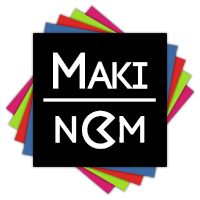Makinom 2.11.0 is here with 18 new features, changes and fixes!
This update adds the dialogue importer to the schematic node editor, (optionally) displays extended information in foldout titles, better support for orthographic cameras, new slider based value bars (HUDs using Unity UI) and other new features, changes and fixes.
You can learn more about the new dialogue importer in this documentation.
Download the latest version of Makinom here.
If you’re enjoying Makinom (or ORK Framework) and the free updates, tutorials and support I’m providing, please consider supporting me as a patron on patreon.com.
New
- Editor: Schematics: Dialogue Importer: New tool to import dialogues into multiple ‘Show Dialogue’ nodes available. Open the tool using the context menu option ‘Open Dialogue Importer’. Comes with 2 built-in import models (‘Separator’ and ‘Markup’), can be extended by custom formats.
- String Values, Variable Fields: The variable keys with local context are now automatically listed at the top of the variables/texts. The button popup beside the string/variable field will list matching scenes at the top under the ‘Local’ sub-menu. Local context refers to variables/texts used within the displayed settings (e.g. a schematic, formula or the game settings).
- String Values, Variable Fields: The names of scenes added to Unity’s build settings are now automatically listed at the top of the variables/texts. The button popup beside the string/variable field will list matching scenes at the top under the ‘Scenes’ sub-menu.
- Editor Settings: Foldout Settings: ‘Extended Information’ setting available. Optionally display more information in the title of some foldouts, e.g. foldouts of array elements showing details on their setup. By default enabled.
- Content Layouts: ‘Use Content Variables’ setting avaialble. Optionally replace variable text codes with variables from the displayed content instead of global variables. If the content doesn’t have variables, the text codes will be replaced with default values (e.g. int/float ‘0’, bool ‘false’, etc.).
- Camera Positions: ‘Orthographic Size’ settings available. Optionally set the camera’s orthographic size. Only used by cameras using ‘Orthographic’ projection.
- UI Boxes: Controls: ‘Limit Accept Click Time’ settings available. Optionally limit the time a click can be held to accept inputs.
- Editor: Foldouts: Many foldout titles of array elements display additional information about their settings when using ‘Extended Information’ in the editor settings.
- Schematics: Change Camera Position: ‘Set Orthographic Size’ settings available when using a target position instead of a camera position. Optionally set the camera’s orthographic size. Only used by cameras using ‘Orthographic’ projection.
- Camera Events: ‘Set Orthographic Size’ settings available. Optionally set the camera’s orthographic size. Only used by cameras using ‘Orthographic’ projection.
- Unity UI: HUD Value Bar (Slider): ‘HUD Value Bar (Slider)’ component available. Displays a value bar’s content using a ‘Slider’ component.
- Unity UI: Context Menu: New variants available for ‘Slider’ value bars.
Changes
- Interactions: Object Turn Settings: Using a 2D setup (i.e. ‘Default Horizontal Plane’ set to ‘XY’ in ‘Game > Game Settings’) will now rotate the game objects on their Z-axis to face the other game object’s position.
Fixes
- Mount Settings: The ‘Scale’ setting (available when enabling ‘Set Scale’) was wrongly named ‘Rotation Offset’.
- HUDs: Fixed an issue that could cause errors when opening a HUD again before closing (animated via schematics) finished. Error appeared after closing the HUD again.
- Unity UI: UI Box Component: Input Settings, Tab Buttons: Fixed an issue where not having a ‘Scroll Rect’ selected was hiding some settings.
- UI Layouts: Fixed an issue where some layout configurations could lead to content that should be placed in the upper left corner of the screen not updating their positions correctly.
- Item Collectors: Fixed an issue where not interactable interactions could still fire their pre-interaction functionality (e.g. moving to interaction).

